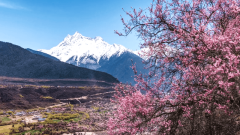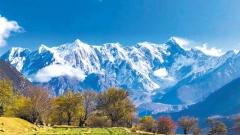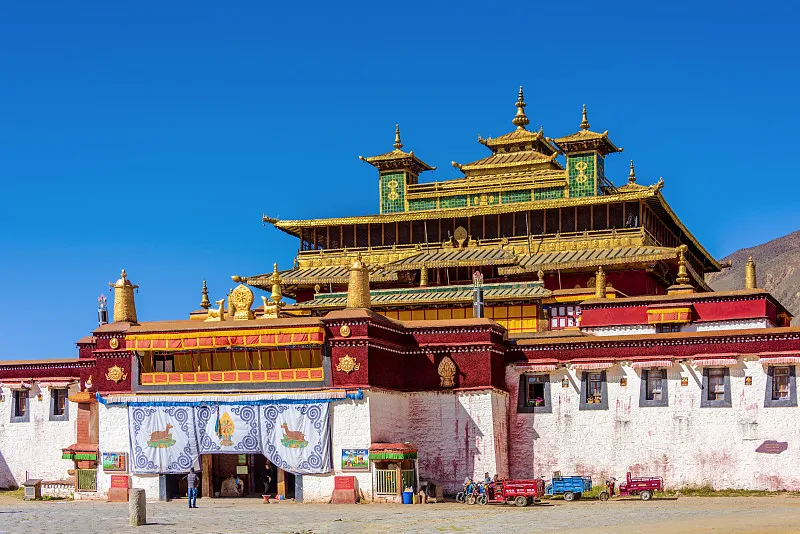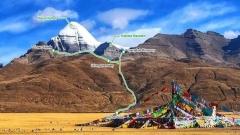Mount Kailash (Ali) is more than a mountain — it’s a crossroads of faith, myth and high-altitude landscape. In 2026, the Tibetan Year of the Horse, many believe that completing a kora around Kailash carries extraordinary merit: a single circuit is traditionally considered equal to thirteen circuits in ordinary years. That rare convergence of celestial timing and sacred geography draws pilgrims, photographers, and adventure travelers from around the world. For overseas visitors, a Kailash pilgrimage combines rigorous trekking, sensitive border and permit procedures, and remote-area logistics that require specialist experience.
Quick Overview — Mount Kailash Kora (Outer Circuit)
- Outer Kora distance: ~52 km (about 40 km walking + ~11 km by vehicle).
- Typical duration: 3–4 days (most overseas visitors complete it in 3 days).
- Trailhead: Taxin (Taqin), altitude ~4,675 m.
- Highest pass: Dolma La (also called Drolma La), ~5,630–5,648 m — the most demanding section.
- Pace on the plateau: expect 2–3 km per hour average; total walking time commonly exceeds 20 hours.
- Direction: clockwise is common among Tibetan Buddhists and Hindu pilgrims; Bon practitioners often go counter-clockwise. Many tourists follow clockwise.
Keep these baseline figures in mind when estimating fitness, acclimatization needs, and gear.
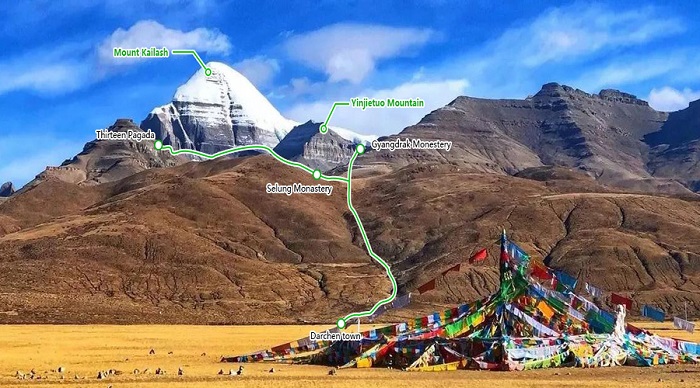
Mt Kailash Yatra
How Overseas Visitors Typically Reach Mount Kailash
1) Via Lhasa (most common, safest, and best for acclimatization)
Route outline: International flight → major Chinese gateway (Beijing/Chengdu/Shanghai) → domestic flight or Qinghai–Tibet Railway to Lhasa → overland drive through Shigatse, Everest region, Saga → Taxin (Kora start).
Pros
- Time in Lhasa (1–2 days) helps altitude acclimatization.
- Easy to combine with Potala, Yamdrok, Everest Base Camp and other highlights.
- Logistics, vehicle standards and medical support are generally more stable.
Cons
- Long overland distances (often 1,000–1,300+ km depending on the route) require multiple days of driving.
2) Overland via Kathmandu (cultural alternative / cross-border route)
Route outline: Fly into Kathmandu → travel to border (e.g., Gyirong or other border points as available) → enter Tibet and continue to Taxin.
Pros
- Combines Nepal’s spiritual and cultural sites with a Tibetan pilgrimage — a unique transnational itinerary.
Cons
- Border conditions, seasonality, and approval procedures vary; more paperwork and time are typically required.
Classic 3-Day Outer Kora — Detailed Day-by-Day
Day 1 — Taxin → Zhire (approx. 20 km: 6 km drive + 14 km hike)
- Morning: Gather in Taxin; transfer by vehicle ~6 km to the trailhead.
- Hike: ~14 km through valleys, gravel paths and alpine meadows; watch for yaks and local pilgrims. Expect 5–7 hours with breaks.
- Highlights: Panoramic views of the western and northern faces of Mount Kailash at different angles.
- Sleep: Simple guest room at Zhire monastery or lodging near the route.
- Notes: If luggage is heavy, arrange pack animals or porters locally (payable on site). Keep a steady, slow pace to conserve energy.
Day 2 — Zhire → Dolma La Pass → Zhochu (approx. 20 km; full day on foot)
- Challenge day: Ascend to Dolma La (the high point at ~5,630–5,648 m). Expect up to 9 hours of walking depending on group pace.
- Scenery: Prayer flags at the pass, views of small tarns (e.g., Tsoji Tso), plus snowy and rocky terrain.
- Descent: After the pass the route descends toward Zhochu.
- Sleep: Monastic accommodation or basic guesthouse at Zhochu.
- Safety: Use trekking poles and footwear with strong grip; be ready for icy / slippery conditions. If severe altitude sickness occurs (intense headache, vomiting, breathlessness), stop and seek leader/guide help immediately — oxygen or descent may be necessary.
Day 3 — Zhochu → Taxin → Zhada (vehicle transfer) (approx. 11 km: 7 km hike + 4 km drive)
- Morning: Final ~7 km walk back toward Taxin; pace eases as altitude drops.
- Transfer: Vehicle pick-up and drive onward to Zhada (or other next destination).
- Wrap-up: Check feet, skin and kit; medical attention if any lingering issues. Overnight in Zhada in a standardized guestroom (often oxygen-assisted).
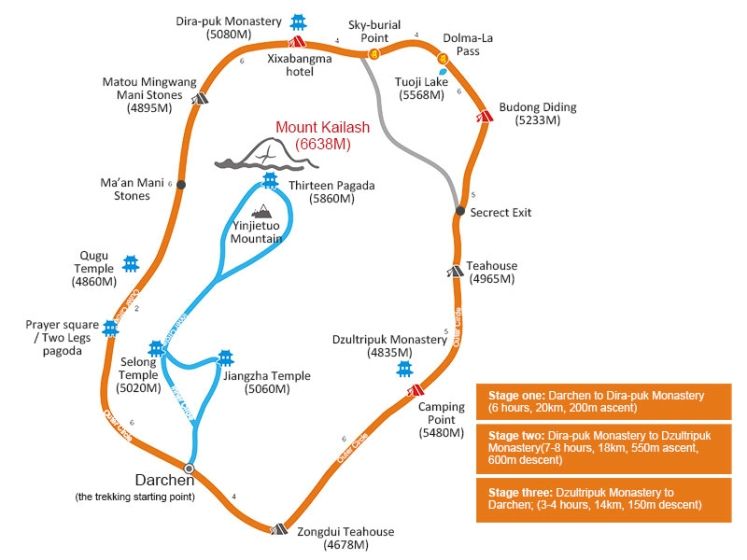
Mt Kailash Yatra Route Map
Extended 15-Day Ali & Kailash Pilgrimage (sample route)
A 15-day program blends ample acclimatization, cultural sites and remote landscapes:
- Lhasa Arrival
- Downtown Lhasa: Potala Palace — Jokhang Temple — Barkhor Street
- Lhasa — Yamdrok Lake — Karola Glacier — Shigatse
- Shigatse — Tingri — E.B.C. — Basong Village
- Basong Village — Tingri — Mt.Shishapangma — Peikutso Lake — Saga
- Saga — Zhongba — Maquan River Wetland Park — Darchen
- Day 1 of Kailash Kora: Darchen – Drirapuk Monastery (Approx. 20 km: 6 km by eco-bus + 14 km trekking)
- Day 2 of Kailash Kora: Drirapuk — Dzultripuk Monastery (Approx. 20 km, full-day trekking)
- Day 3 of Kailash Kora: Dzultripuk Monastery — Darchen — Zanda (Approx. 11 km: 7 km trekking + 4 km by vehicle)
- Zanda — Zanda Earth Forest — Guge Kingdom — Darchen
- Darchen — Mount Kailash & Lake Manasarovar — Saga
- Saga — Peikutso Lake — Shigatse
- Shigatse — Jiegangri Sacred Mountain — Serling Tso Lake — Baingoin County
- Baingoin County — Namtso Lake(Tashi Peninsula) — Nagenla Pass — Nyenchen Tanglha Mountain-Lhasa
- Lhasa Airport Transfer — End of Trip
This schedule allows repeated moderate-altitude stops for safer acclimatization and richer cultural immersion.
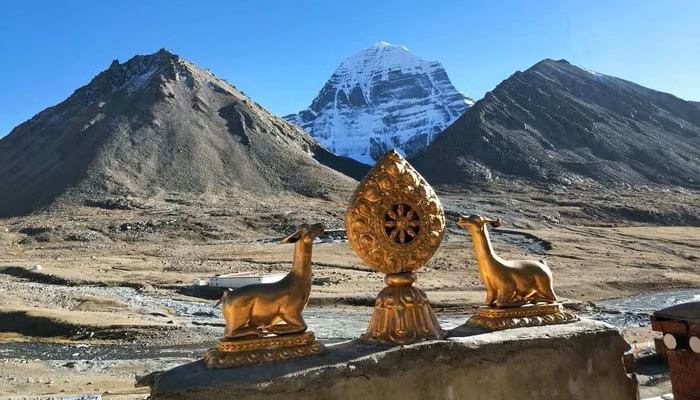
Mt Kailash Kora
Kailash Kora Cost Overview for Overseas Travelers
- 15-day Ali pilgrimage package (example): ~$1940-2235 (approx. RMB ¥13,980–15,980).
- International airfares: depend on origin and booking timing — examples from East Asia were listed previously; overseas travelers should expect variable costs.
- On-trip personal expenses: souvenirs, extra meals, last-minute pack animals / porters, tips — budget an additional $260–400.
- Pack animals / porters (local, pay on site or via agency):
-
- Yak rental: ~RMB 380/day (typical 20 kg load).
- Horse: ~RMB 410/day.
- Porter: ~RMB 400/day (carries limited weight).
- Herder/handler: ~RMB 400/day.
Total rough estimate for a complete 15-day Kailash Kora tour: ~$2800–3760 (seasonal and service level fluctuations apply).
Booking note: China Dragon Travel can provide tailored quotes including permit handling, ground transport, accommodation standards, guide and driver services, and optional extras. Always confirm which items are included/excluded before payment.
Permits & Paperwork for Overseas Visitors to Kailash
- Tibet Entry Permit (Tibet Travel Permit / “Tibet Permit”) is mandatory and must be obtained through a licensed local travel agency; individuals cannot apply on their own.
- How it works: Contact an authorized agency (like China Dragon Travel) → confirm itinerary and sign electronic contract → pay deposit → submit passport copy and visa info → agency applies to the relevant authorities and secures the permit and any required military or border approvals.
- Timing: Apply several weeks in advance; border routes (e.g., via Nepal) require extra coordination.
- Reminder: Permit procedures and windows vary — book early to avoid last-minute complications.
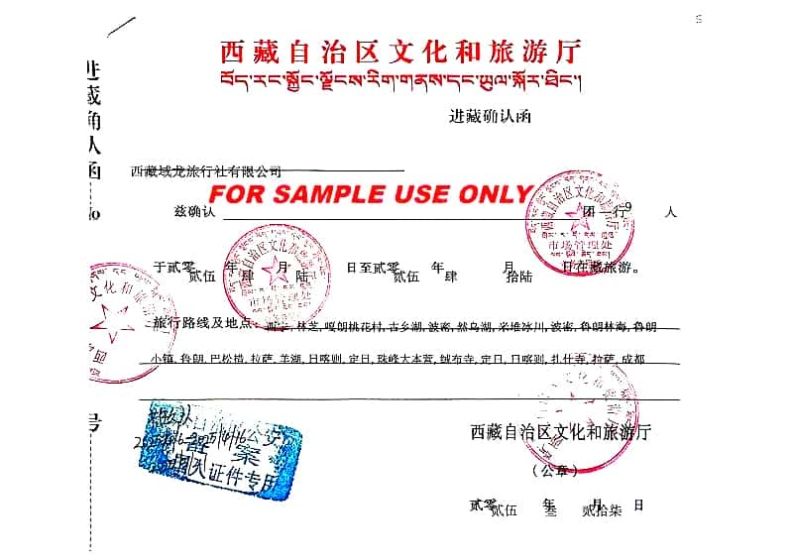
Tibet Travel Permit
Recommended Kits for Kailash Kora
Clothing & footwear
- Waterproof, breathable shell (Gore-Tex style).
- Insulating down jacket (lightweight but warm).
- Mid-layers (fleece / quick-dry).
- Moisture-wicking base layers and multiple socks.
- High-ankle, waterproof trekking boots with good traction; spare insoles.
Head & skin protection
- UV sunglasses, wide-brim hat and warm beanie.
- High-SPF sunscreen and lip protection.
Hands & trekking aids
- Thin liners + waterproof outer gloves.
- Two trekking poles recommended for stability.
Sleep & electronics
- Lightweight sleeping bag or liner (for hygiene/warmth).
- Headlamp with spare batteries; power bank (battery life reduced in cold).
Medical & food
- Personal medications (prescription and routine).
- Altitude medication (e.g., acetazolamide) only under physician advice.
- Basic first-aid kit (plasters, disinfectant, analgesics, antidiarrheal).
- High-energy snacks: nuts, chocolate, energy bars, rehydration salts.
Documents & cash
- Passport, visa, Tibet permit copy, travel insurance with high-altitude evacuation cover.
- Some RMB cash for remote purchases, porter rentals, tips.
Altitude lllness: Prevention and Response
Prevention principles
- Slow, staged ascent; rest days in Lhasa or lower altitudes before deep-plateau travel.
- Maintain hydration and consume calorie-dense foods.
- Keep walking pace gentle; don’t rush ascents.
- Obtain travel insurance covering high-altitude rescue/evacuation.
Symptoms & actions
- Mild: headache, fatigue, poor sleep — rest, hydrate, consider oxygen or OTC pain relief.
- Moderate: persistent headache, vomiting, shortness of breath — stop, alert leader/guide, consider descent or medical care.
- Severe: confusion, inability to walk, severe breathlessness — emergency descent and urgent medical evacuation.
Always follow your guide’s instructions; guides carry oxygen and have evacuation plans.
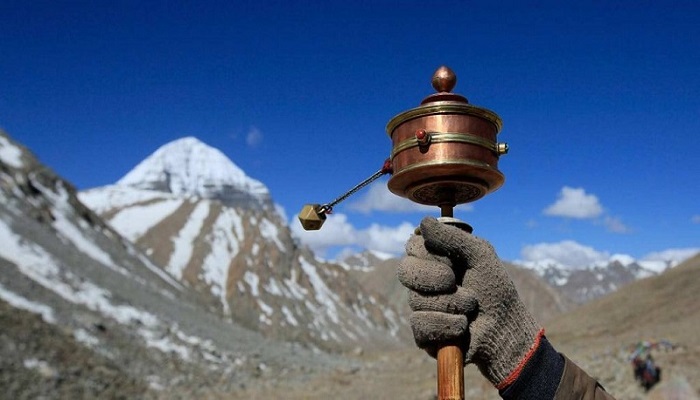
Mt Kailash Yatra
FAQs for Overseas’ Kailash Kora
Q: Can I join the kora independently?
A: No. Overseas visitors must travel with an authorized tour operator who handles the Tibet Travel Permit and local logistics. Group travel is required for permit approval.
Q: Do I need to bring a sleeping bag?
A: Local guesthouses and monasteries often provide basic bedding. If you require extra hygiene or warmth, bring a lightweight sleeping bag or liner.
Q: Are pack animals safe?
A: Yaks and horses are commonly used and generally reliable when handled by experienced locals. Confirm load limits (yak ~20 kg) and safety arrangements with your agency. China Dragon Travel will assist with arranging reputable porters/animals.
Q: Are meals included on the 3-day kora?
A: Meal inclusion varies by package. Confirm with China Dragon Travel whether your selected program covers food on the kora days.
Q: How to choose a travel agency?
A: Look for a locally registered, licensed Tibetan operator able to secure the Tibet Travel Permit and any military/border clearances; transparent pricing that lists inclusions/exclusions; experienced guides and drivers familiar with Ali routes; and clear emergency protocols. China Dragon Travel offers multilingual support and full permit processing for overseas groups.
Plan Your Kailash Kora Trek with China Dragon Travel
Because Mount Kailash lies in a remote, sensitive region with strict permit rules and challenging terrain, careful planning is essential. China Dragon Travel specializes in managing the necessary approvals, customizing itineraries for overseas pilgrims, and coordinating safety, logistics, and cultural briefings so you can focus on the pilgrimage itself.



